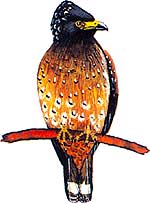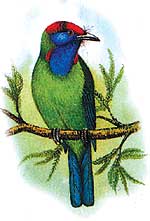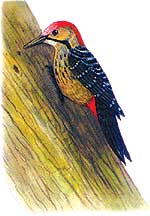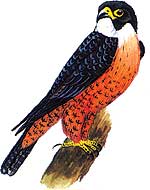 Kathmandu is one of the few capitals in the world where the suburbs border a national park. The other one that springs to mind is Nairobi.
Kathmandu is one of the few capitals in the world where the suburbs border a national park. The other one that springs to mind is Nairobi. Dominating the capital's northern horizon is the Shibapuri National Park, a walled sanctuary that doesn't just protect an awesome biodiversity, but also the vital watershed for Kathmandu Valley with springs that feed the Bagmati and Bishnumati.
Designated a national park two years ago, the 144sq km mixed forest of oak, pine, birch and rhododendron, countless varieties of orchids and 3,000 types of flowering plants is home to 102 species of butterflies and a number of dragonflies. Within the 111km walls of the park, thrive 20 percent of all the orchid species found in Nepal. Come rhododendron season, the park is ablaze with red, pink and white and on the forest floor, more than 129 species of mushrooms have been identified. This is also a birdwatcher's paradise with 177 species that either live or stop over here on their migratory route-almost one-fourth of all the bird species found in Nepal.
 Geography has everything to do with it. Nepal's leading orinthologist, Hari Saran Nepali, explains: "Birds don't like very cold climates. At Shibapuri, the base of the south face starts at 1,400m and the base of the north face at 500m. It's ideal for birds that travel south in winter and north in summer." Instead of migrating large distances, the birds simply fly up or down the mountain!
Geography has everything to do with it. Nepal's leading orinthologist, Hari Saran Nepali, explains: "Birds don't like very cold climates. At Shibapuri, the base of the south face starts at 1,400m and the base of the north face at 500m. It's ideal for birds that travel south in winter and north in summer." Instead of migrating large distances, the birds simply fly up or down the mountain! Nepal is home to 850 of the world's estimated 9,000 species of birds. Shibapuri is special because it is an undisturbed forest, unlike Godabari where regular dynamiting for marble scares off both birds and humans. Nepali is sad to note that several species in Godabari have become so rare as to warrant concern over extinction. In 50 years of birdwatching, he has seen the numbers of the slender bill scimitar babbler, blue winged laughing thrush, gray sided laughing thrush, bar tailed cuckoo dove, mountain hawk eagle, booted and black eagles and the white georgeted flycatcher fall alarmingly.
 There are nine species on the government's protected list, of which the cheer pheasant, lesser and Bengal floricans, monal and sarus crane are among the 29 globally endangered bird species. Nepali has only seen the slender bill scimitar babbler on Shibapuri. "Though these birds should be seen along the Valley rim according to the range, this could indicate there are very few left," he says. But there is a problem with drawing such conclusions because longterm studies are absent. In 1961, Nepali recorded a sighting of a blue winged laughing thrush in Shibapuri. The next time he recorded such a sighting was in 1986, at Godabari. But the same bird is almost common in the Makalu-Barun area. Research requires funding, hard work and dedication. Nepali knows there are too few who are willing to devote their lives to Nepal's birds.
There are nine species on the government's protected list, of which the cheer pheasant, lesser and Bengal floricans, monal and sarus crane are among the 29 globally endangered bird species. Nepali has only seen the slender bill scimitar babbler on Shibapuri. "Though these birds should be seen along the Valley rim according to the range, this could indicate there are very few left," he says. But there is a problem with drawing such conclusions because longterm studies are absent. In 1961, Nepali recorded a sighting of a blue winged laughing thrush in Shibapuri. The next time he recorded such a sighting was in 1986, at Godabari. But the same bird is almost common in the Makalu-Barun area. Research requires funding, hard work and dedication. Nepali knows there are too few who are willing to devote their lives to Nepal's birds.  Nepal Nature.com was started by Karna Sakya, a forester by training and president of KGH Group of Hotels and Resorts, who is interested in using the expertise of specialists like Nepali to promote birdwatching. On Christmas Day this year, it organised a half-day Christmas Bird Count. Starting from verdant Park Village Resort, birdwatchers walked around its six acres and immediately, Nepali spotted a red-vented bulbul perched on a tree. From an electrical wire, a kingfisher created a splash of colour in brilliant turquoise as it took flight.
Nepal Nature.com was started by Karna Sakya, a forester by training and president of KGH Group of Hotels and Resorts, who is interested in using the expertise of specialists like Nepali to promote birdwatching. On Christmas Day this year, it organised a half-day Christmas Bird Count. Starting from verdant Park Village Resort, birdwatchers walked around its six acres and immediately, Nepali spotted a red-vented bulbul perched on a tree. From an electrical wire, a kingfisher created a splash of colour in brilliant turquoise as it took flight.  From the hotel, it is a 10-minute drive to the gate of Shibapuri National Park, accessible for Rs 10 each (Rs 250 for tourists). Armed with binoculars (7x40 with a 8.6 degree wide angle is best), park warden Phanindra Kharel headed his group down the forest trail and up to cross a little stream. A colourful danphe, Nepal's national bird, crossed the trail leisurely, unaware he was being watched. Kharel pointed out wabblers shuttling from branch to branch so quickly that our eyes could barely keep up. By the end of the morning, the visitors had counted 52 species of birds.
From the hotel, it is a 10-minute drive to the gate of Shibapuri National Park, accessible for Rs 10 each (Rs 250 for tourists). Armed with binoculars (7x40 with a 8.6 degree wide angle is best), park warden Phanindra Kharel headed his group down the forest trail and up to cross a little stream. A colourful danphe, Nepal's national bird, crossed the trail leisurely, unaware he was being watched. Kharel pointed out wabblers shuttling from branch to branch so quickly that our eyes could barely keep up. By the end of the morning, the visitors had counted 52 species of birds. Kharel is proud of Shibapuri's achievements in the past two years. "From 1984 there has been a total rehabilitation of erosion and bare patches. The wildlife has increased, leopard numbers have gone up and so has the volume of water, indications that the natural environment has improved."
 The park, so close to Kathmandu, is ideal for special interest tourism. Rajendra Narsingh Suwal, managing director of Nepal Nature.com, says, "Nepal is ideal for watching monkeys, and butterflies like the rare Kaiser-i-Hind that appears for only one summer month." The relict dragonfly, found only in fossil form in Japan, is still flitting around the hills of Shibapuri today.
The park, so close to Kathmandu, is ideal for special interest tourism. Rajendra Narsingh Suwal, managing director of Nepal Nature.com, says, "Nepal is ideal for watching monkeys, and butterflies like the rare Kaiser-i-Hind that appears for only one summer month." The relict dragonfly, found only in fossil form in Japan, is still flitting around the hills of Shibapuri today. www.birdlifenepal.com
www.nepalnature.com
Kosi birds
It's that time of year when seasonal birdwatchers throng to Kosi Tappu to catch migratory birds as they flock down from Siberia through the Tibetan plateau down the Arun gorge to warmer climes. Ducks and geese are especially fond of the reservoir created by the Kosi Barrage, 88m above sea level-Nepal's lowest point. Some 467 species of migratory and resident birds have been sighted here, sometimes in flocks of 50,000 migratory waterfowl at a time. Birdlovers can expect to see any of 30 varieties of shore birds, 114 kinds water birds, 20 duck species or a couple from the ibis family. The 175sq km reserve is also the largest heron sanctuary in Nepal.
This year's annual Migratory Birds Festival is from 18-25 January.


